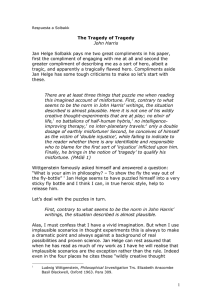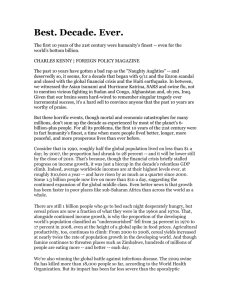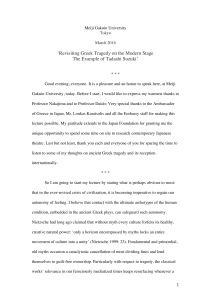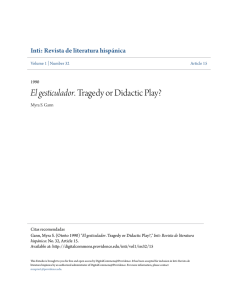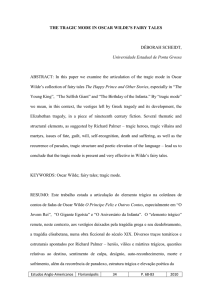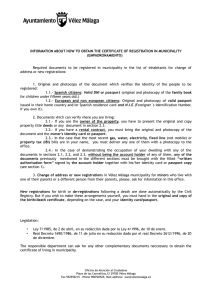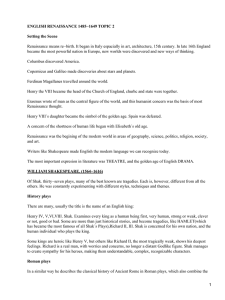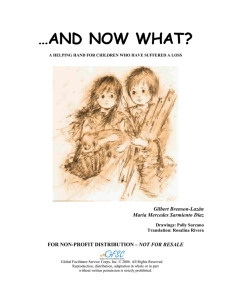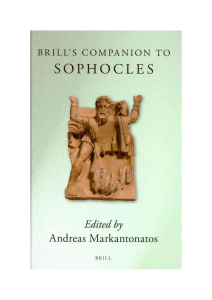Some Remarks on Tragedy and on Vélez as a Tragedian (A
Anuncio
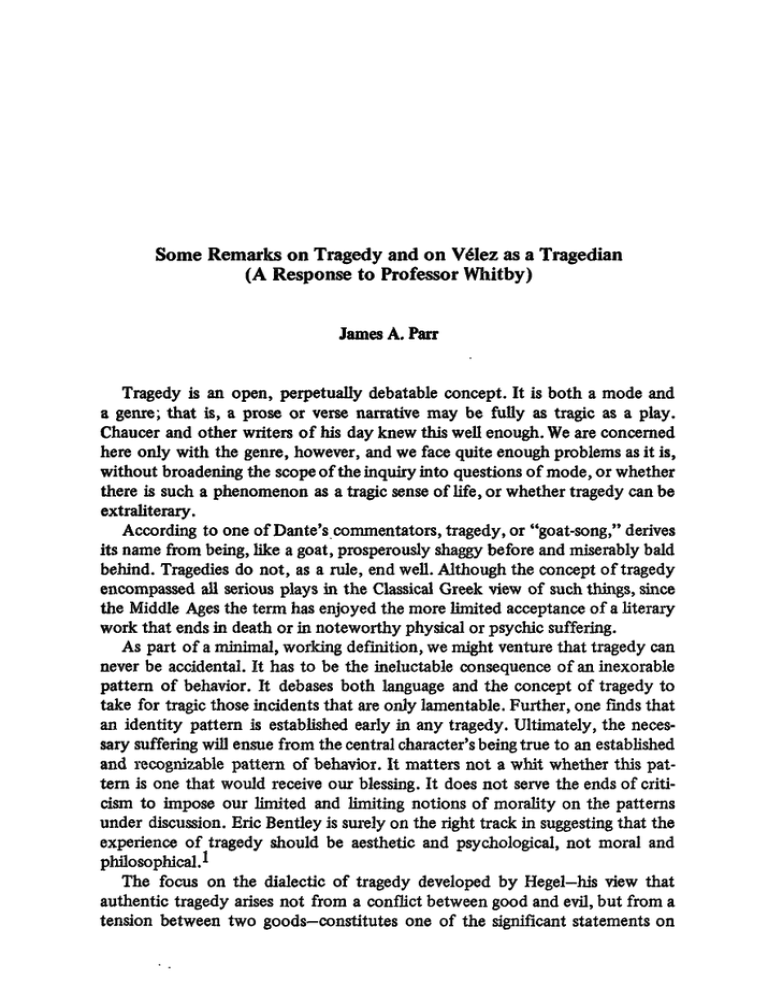
Some Remarks on Tragedy and on Vélez as a Tragedian
(A Response to Professor Whitby)
James A. Parr
Tragedy is an open, perpetually debatable concept. It is both a mode and
a genre; that is, a prose or verse narrative may be fully as tragic as a play.
Chaucer and other writers of his day knew this well enough. We are concerned
here only with the genre, however, and we face quite enough problems as it is,
without broadening the scope of the inquiry into questions of mode, or whether
there is such a phenomenon as a tragic sense of Ufe, or whether tragedy can be
extraliterary.
According to one of Dante's commentators, tragedy, or "goat-song," derives
its name from being, like a goat, prosperously shaggy before and miserably bald
behind. Tragedies do not, as a rule, end well. Although the concept of tragedy
encompassed all serious plays in the Classical Greek view of such things, since
the Middle Ages the term has enjoyed the more limited acceptance of a literary
work that ends in death or in noteworthy physical or psychic suffering.
As part of a minimal, working definition, we might venture that tragedy can
never be accidental. It has to be the ineluctable consequence of an inexorable
pattern of behavior. It debases both language and the concept of tragedy to
take for tragic those incidents that are only lamentable. Further, one finds that
an identity pattern is established early in any tragedy. Ultimately, the necessary suffering will ensue from the central character's being true to an established
and recognizable pattern of behavior. It matters not a whit whether this pattern is one that would receive our blessing. It does not serve the ends of criticism to impose our limited and limiting notions of morality on the patterns
under discussion. Eric Bentley is surely on therighttrack in suggesting that the
experience of tragedy should be aesthetic and psychological, not moral and
philosophical.^
The focus on the dialectic of tragedy developed by Hegel—his view that
authentic tragedy arises not from a conflict between good and evil, but from a
tension between two goods—constitutes one of the significant statements on
138
Vélez de Guevara
this central question. Hegel's contribution is valuable principally for the
nonmoralistic orientation it advocates. Friedrich Nietzsche's ApoUonianDionysian distinction is likewise one of those central insights into critical
theory that we must sooner or later come to terms with, as Northrop Frye
quite rightly maintains in his illuminating study of Shakespearean tragedy/
In discussions of Spanish Golden Age tragedy, there is frequently a tendency
to confuse values with moralizing. The search for value has too often become a
search for the moralistic intent of the dramatist or, indeed, of the genre as a
whole. While I would agree that one cannot separate values from literature and
hope to retain much that will be worth the salvaging, it seems to me essential
that we do make every effort to separate moralizing from criticism and that we
strive to avoid the sort of reductive interpretation that results from the wholesale application of the principle of poetic justice. The question is whether a
nonmoralistic approach is viable in the case of the comedia, a family of drama
that has traditionally been treated as the product of a rather unique set of
circumstances.
Now I will readily grant that Counter-Reformation literature is characteristically tinged with didacticism, but I would also ask whether it is necessary
to expend the time and energy that have been devoted to demonstrating this
conspicuous fact in play after play. There is perhaps no need to belabor the
obvious.
What I should advocate is, first of all, an orientation grounded in the
baroque aesthetic ideal of admiratio and, second, one that emphasizes the more
positive aspects of virtus, oiareté, rather than the somewhat negative, moralistic
concept of hamartia. I would attempt to combine historical criticism with literary criticism, pointing again toward the kind of synthesis of these two basic
approaches that I have been urging for some time.
To begin with the historical dimension, let me suggest that the desire to
achieve admiratio, or admiración, is fully as developed a drive in the baroque
artist as is the desire to instruct. The Horatian ideal of combining the useful
with the sweet {utile et dulce) continues to thrive throughout the baroque in
Spain. Tirso's deleitar aprovechando translates in practice into a clear emphasis
on didacticism, on the one hand, and a corresponding emphasis on the aesthetic
dimension of admiratio on the other. Whether we choose to emphasize the
one or the other is largely attributable to individual temperament. Here is
where the subjective enters criticism, in the choice of materials and in the
method and emphasis, and we deceive ourselves if we presume to Olympian
objectivity in these matters. The most that can be hoped for in this regard is
an enlightened and disciplined subjectivity.
Another facet of the historical dimension is that the shade of Aristotle
loomed even larger in the time of Vélez than it does now. The Poetics is a
description that became a prescription, and a millstone around the neck of
tragedy, because, as F. L. Lucas points out, "the Greek philosopher was not
James A. Parr
139
studied in the Greek spirit of sceptical inquiry, but rather as if he had been a
Hebrew prophet verbally inspired."-*
Aristotle stipulated that the characters of tragedy must be as "good" or as
fine in character as the plot permits (but not perfect), that they must be true
to type, and that they must be "consistent" or true to themselves (Poetics
XV.1-5). Such unheroic characters as Don Juan Tenorio or the Antichrist
are, one might argue, as fine in character as those particular plots will permit.
We remember that another of Aristotle's principles is that art can make a fine
picture even of a toad. It should also be borne in mind that the pagan ideal of
virtue demanded strength and intensity of character rather than purity of soul.
Greek ethics, F. L. Lucas observes, had a larger element of aesthetics.^
Peter Alexander maintains that catharsis is the central concept of the
Poetics, since this notion is basic to Aristotle's refutation of Plato's negative
view of certain kinds of imitation, and that hamartia is merely a form of
hypothesis put forward to account for this phenomenon. To focus on hamartia
as the primary concept is to put the cart before the horse, says Alexander.-*
The two emotions to be indulged in the achievement of catharsis are pity
and fear, the former synonymous with sympathy or involvement, the latter
more conducive to alienation or distancing. Seen thus, pity and fear are transmuted into aesthetic concepts reflecting the equilibrium between involvement
and distancing that is characteristic of most serious art.
Hamartia has been defined as an error in judgement (Bywater), missing the
mark (Kitto), a false step taken in blindness (Lucas), an unforeseen failure
(Brereton), or the misidentification of a person (Else). Lattimore's empirical
evidence shows that hamartia in the extant Greek tragedies refers to an act, not
a trait: " . . . the word . . . cannot signify a permanent characteristic in a person,
pride, quickness to anger, etc., but must refer to a mistaken or wrong act or to
a mistake that has been made."^
Peter Alexander has suggested that tragedy takes its character and significance
not from faults but from "virtue," that is, virtus (arete in the Greek), amoral
strength of character, all the qualities that make an individual formidable, as
Machiavelli put it. It is the tendency of the protagonist to identify his whole
being with some interest, object, passion, or habit of mind that is, as A. C.
Bradley once wrote, the "fatal gift which carries with it a touch of greatness."'
From the studies of Lucas and Lattimore of the plot structures of ancient
Greek tragedies, it is apparent that Aristotle has derived the hamartia doctrine
not from the works themselves but from his own moral views. Roger L. Cox
points to this fact and goes on to give what I find to be the most sensible
definition of the term: 'The doctrine of hamartia is simply an attempt to take
into account the obvious fact that the protagonist is partly though not entirely
responsible for the suffering which is essential to tragedy."8
We come now to more practical considerations. Begging Professor MacCurdy's
indulgence, I will assume, with Professor Whitby, that Vélez's La serrana de la
140
Vélez de Guevara
Vera, Reinar después de morir, and Los celos hasta los cielos y desdichada
Estefanía are, all three, tragedies.
La serrana de la Vera illustrates a variation on A. A. Parker's thesis concerning santos y bandoleros. Act III gives us the inversion of the remarkable
traits and feats of courage and strength illustrated in Acts I and II. Gila's
pattern of behavior, her tenacious individualism, indeed rebelliousness, has
merely been magnified—and, of course, perverted—in Act III; but there is more
continuity than change. She remains true to herself, at one with her self-image
of La serrana de la Vera. The crisis at the end of Act II merely serves to
channel her boundless energy in a different direction. She remains a larger-thanlife character throughout, one who responds perfectly to the aesthetic demand
for the arousal of turbación and admiración. We would diminish Vélez's
achievement in delineating this remarkable creature were we to give any
weight at all to considerations of crime and punishment. Gila's fall results,
needless to say, from actions for which she is at least in part responsible. The
inevitability of her fall issues from her character. She is, to use Nietzsche's
terms, a Dionysian force at odds with an Apollonian world. In Hegelian terms,
her highly personal need for revenge on all representatives of the gender that
has repressed and abused her comes into conflict with society's need for law
and order.
Reinar después de morir is a very different play. If La serrana de la Vera is,
symbolically, the tragedy of the killing of the father (i.e., the dominant male
figure), Reinar después de morir is the tragedy of the sacrifice of the son
(i.e., the innocent victim). I concur with Professor Whitby in his insight that
Reinar después de morir follows the model of Antigone in presenting a character who is forced to choose between two imperatives: personal obligations, on
the one hand, and the demands of the state, on the other. Don Pedro's unswerving allegiance to Inés de Castro is exemplary, but it leads inexorably to tragic
suffering. Such is the irony of tragedy. The murder of Inés is lamentable, but it
is not tragic. It is Pedro's response to her death, and the dignity that he confers
upon it and with which he meets it, that afford the tragic dimension. He is the
central character, the one on whom the greater part of the action hinges, and it
is his behavior pattern of indecisiveness that culminates in death for Inés and
psychic suffering for him. Better than either of the other two plays we are
considering, Reinar después de morir exemplifies Hegel's view of the tragedy
of two conflicting "goods," here political versus individual, resulting in the
unavoidable waste of human excellence (Inés) and the mental anguish (Pedro)
that accompanies such a loss.
Los celos hasta los cielos y desdichada Estefanía is an Oedipus-type tragedy
or, in terms of Christianity, a tragedy of the isolation of the spirit.^ Like
Oedipus, Fernán Ruiz is driven to know the truth about certain matters which,
because of the way they are brought to light, lead to spiritual isolation and
remorse for him, and death for Estefanía. This is a terribly ironic play, for the
James A. Parr
141
truth that Femando thinks he has uncovered is only an illusion. Not until he
has murdered Estefanía are the facts revealed to him. His hamartia, his "false
step taken in blindness," is the killing of his wife. The inevitability of the step
issues from his character, conditioned as it is by certain social imperatives.
The final calamity contrasts here, as in the other two plays, with an earlier
glory and happiness. As in the case of Reinar después de morir, there is an
innocent female victim, but it is the male lead who is seen to suffer; although
Inés and Estefanía perish, neither is shown to experience the sort of suffering
that is essential to tragedy. Nor do we see a final anagnorisis or transcendence
in either.
Vélez offers us three types of tragedy in as many plays. From this simple
fact, a valid inference might be that it is a risky proposition to speak of
"Calderonian" or "Alarconian" or "Lopean" tragedy as though these complex
major figures presented a unified, monolithic view of the matter, when a
dramatist such as Vélez de Guevara offers such complexity. And it would
seem to be foolhardy indeed to propose a monolithic view of the tragedy
of the entire Spanish baroque.
In commenting upon Vélez's tragedies, it is not necessary to indulge in
evaluation. It is sufficient to say that each play is different. Evaluation is the
least useful, and the most suspect, of all critical procedures. There are certain
significant commonalities in these plays, of course: innocent victims die in
all three; in no case is the protagonist an innocent victim; the principle of
poetic justice is irrelevant to all three; hamartia, if conceived in moralistic
terms, is equally irrelevant; and there is a clear affirmation of human dignity—
a transcendence, if you will—in the way each central character accepts the
final circumstances of the action.
F. L. Lucas asserts that ". . . there is no . . . rule about the character of
tragic characters except that they must have character," adding that ". .. not
wickedness, but weakness, remains the hardest of all human qualities to make
dramatic."^" It is no small achievement, therefore, to have succeeded in
making a weak character such as Don Pedro oí Reinar después de morir central
to the plot of that story. Don Pedro is, in a sense, a "modern" tragic figure,
precisely because of his irresoluteness. We would not be going too far astray
to think of him as the Willy Loman of princes.
To paraphrase L. L. Schücking's view of Shakespearean drama, Golden Age
tragedies need not be read as moral exempla, helping to check the passions,
nor as real-life imitations, inviting the purgation of them. The great energy,
plenitude of power, exuberance, and heightened contrasts of the baroque
lead to the creation of sensational and impressive figures, such as Gila of
La serrana de la Vera, who outstrip real-life representation in their intensity,
eccentricities, extravagances, and self-exaltation.^ F. L. Lucas expresses it
well when he observes that "provided a person has some redeeming qualitycourage, intellect, beauty, wit, passionate devotion; provided they show
Vélez de Guevara
142
some sort of magnificence—then it is astonishing how much their fellow-men
can sometimes forgive them." 12 Eric Bentley cites a story to the effect that
Racine wrote Phèdre to demonstrate that a good poet could inspire sympathy
even with evil characters. Vélez de Guevara achieves much the same effect
with Act III of La serrana de la Vera.
The gamut of possible endings illustrated in the three plays briefly discussed
here shows remarkable versatility and imagination on the part of Vélez and, by
extrapolation, suggests that certain sweeping generalizations that have been
advanced regarding other playwrights and the comedia as a whole may need
to be reexamined. I have found Northrop Frye's typology useful in approaching Vélez, but no doubt different foci may yield equal or greater insight into
other dramatists. With due respect to the system-builders, there can be no one
best approach to the comedia, to tragic drama, or to the work of a single
author. All approaches have some validity, and overviews of the genre, the
period, and of the complete work of the various authors are all useful, but
in the final analysis each play is sufficiently unique to merit an exploration of
its own peculiar dynamic. Contexts are extremely important; it is perilous
to disregard those that are pertinent, but the text itself must always have
first claim to our attention. General tendencies and patterns should invariably
yield to specificity.
Notes
1 Eric Bentley, The Life of the Drama (London, 1965), p. 293.
2 Fools of Time: Studies in Shakespearean Tragedy (Toronto, 1967), p. 10.
3 F. L. Lucas, Tragedy: Serious Drama in Relation to Aristotle's Poetics (London,
1961), p. 12.
4
Lucas, p. 126.
5
Hamlet: Father and Son (Oxford, 1955), p. 57.
6
Richmond A. Lattimore, Story Patterns in Greek Tragedy (Ann Arbor, Mich.,
1964), p. 19.
1 Shakespearean Tragedy (New York, 1949), p. 20.
8
'Tragedy and the Gospel Narratives," The Yale Review, 58 (1968), p. 557.
9 The typology for the three plays under discussion is borrowed from Northrop
Frye, Fools of Time.
James A. Parr
143
10 Lucas, p. 128.
11 Levin Ludwig Schiicking, The Baroque Character of the Elizabethan Tragic Hero
(London, 1938), p. 28.
12 Lucas, p. 129.
